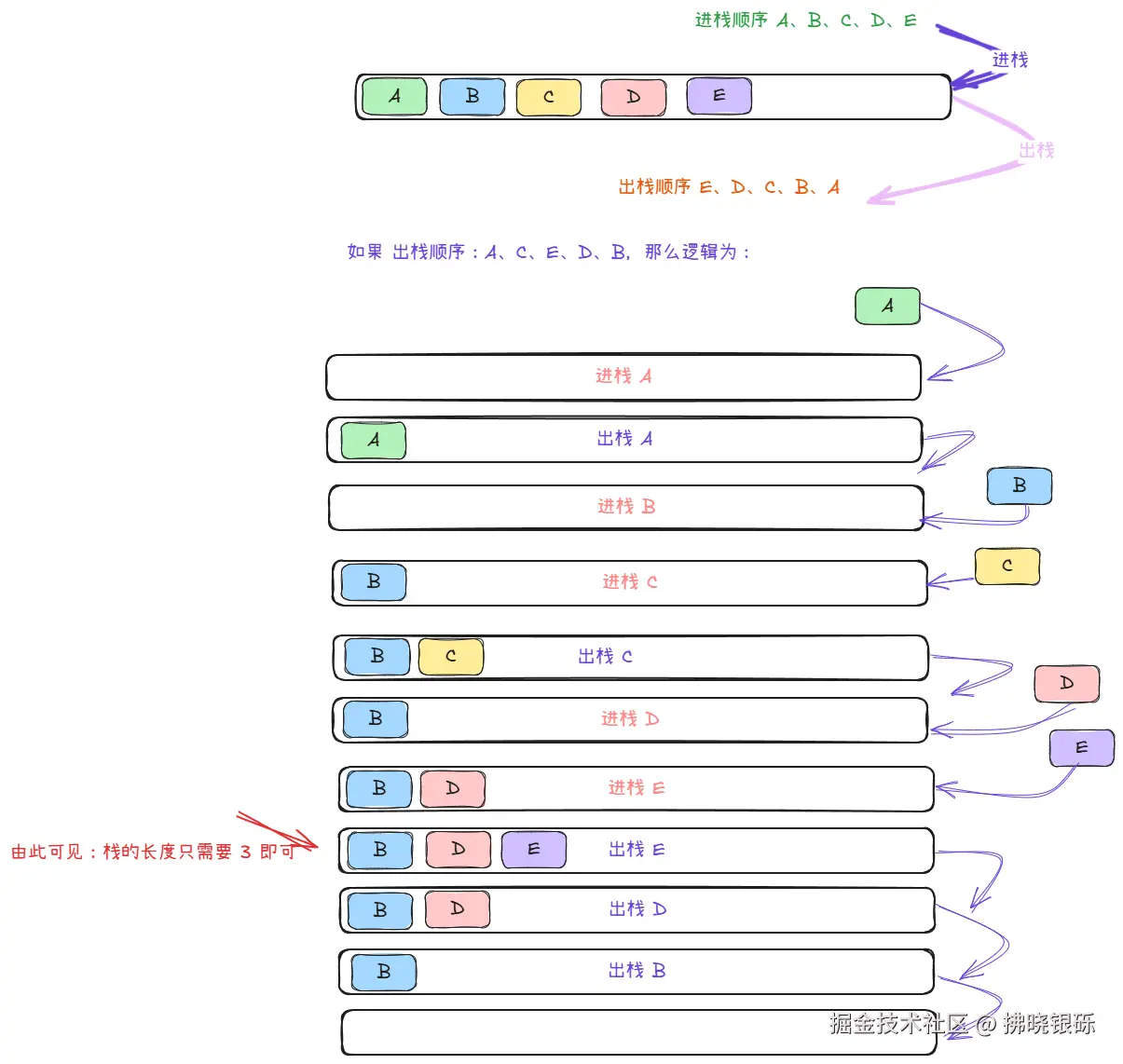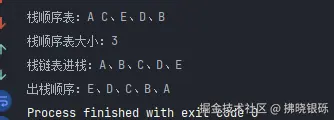栈是一个运算受限的先进后出的线性表。仅限在表的一端进行运算操作操作

代码实现
接口
java
public interface Stack<E> {
/**
* 进栈
*
* @param e 元素
* @throws NullPointerException 不允许空元素
*/
void push(E e);
/**
* 退栈
*
* @return 返回弹出元素
* @throws java.util.NoSuchElementException 没有元素错误
*/
E pop();
/**
* 取栈顶
*
* @return 返回栈顶元素
* @throws java.util.NoSuchElementException 没有元素错误
*/
E getTop();
/**
* 是否空栈
*
* @return 返回结果
*/
boolean isEmpty();
/**
* 检查元素是否为空指针
* @param e 元素
*/
default void check(E e) {
if (e == null) {
throw new NullPointerException();
}
}
}顺序表实现
java
public class StackSequence<E> implements Stack<E> {
private Object[] elementData;
/**
* 游标
*/
private int top;
public StackSequence(int initialCapacity) {
this.top = -1;
if (initialCapacity <= 0) {
elementData = new Object[10];
return;
}
elementData = new Object[initialCapacity];
}
@Override
public void push(E e) {
check(e);
++top;
if (top == elementData.length) {
grow();
}
elementData[top] = e;
}
private void grow() {
// 当前值的1.5倍
elementData = Arrays.copyOf(elementData, (elementData.length + 1) / 2 * 3);
}
@Override
@SuppressWarnings("unchecked")
public E pop() {
if (top < 0) {
throw new NoSuchElementException();
}
Object elementDatum = elementData[top];
elementData[top] = null;
top--;
return (E) elementDatum;
}
@Override
@SuppressWarnings("unchecked")
public E getTop() {
if (top < 0) {
throw new NoSuchElementException();
}
return (E) elementData[top];
}
@Override
public boolean isEmpty() {
return top < 0;
}
public int size() {
return elementData.length;
}
}栈链表实现
java
public class QueueLink<E> implements Queue<E> {
protected Node<E> head;
protected Node<E> rear;
public QueueLink() {
this.rear = new Node<>(null, null);
this.head = new Node<>(null, this.rear);
}
@Override
public void enqueue(E e) {
check(e);
rear.element = e;
Node<E> node = new Node<>(null, null);
rear.next = node;
rear = node;
}
@Override
public E dequeue() {
Node<E> next = head.next;
check(next.element);
head.next = next.next;
return next.element;
}
@Override
public boolean isEmpty() {
return head.next.element == null;
}
@Override
public E getHead() {
E element = head.next.element;
check(element);
return element;
}
protected static class Node<E> {
private E element;
private Node<E> next;
public Node(E element, Node<E> next) {
this.element = element;
this.next = next;
}
public E getElement() {
return element;
}
public void setElement(E element) {
this.element = element;
}
public Node<E> getNext() {
return next;
}
public void setNext(Node<E> next) {
this.next = next;
}
}
}代码测试
Java
/**
* @author DawnStar
* @since 2025/8/2
*/
public class StackTest {
public static void main(String[] args) {
// 顺序表实现
StackSequence<String> stack = new StackSequence<>(3);
System.out.print("栈顺序表:");
stack.push("A");
System.out.print(stack.pop());
stack.push("B");
stack.push("C");
System.out.print(" " + stack.pop());
stack.push("D");
stack.push("E");
System.out.print("、" + stack.pop());
System.out.print("、" + stack.pop());
System.out.print("、" + stack.pop() + "\n");
System.out.println("栈顺序表大小:" + stack.size());
Stack<String> linkStack = new StackLink<>();
List<String> elements = List.of("A", "B", "C", "D", "E");
System.out.println("栈链表进栈:" + String.join("、", elements));
for (String element : elements) {
linkStack.push(element);
}
System.out.print("出栈顺序:");
while (!linkStack.isEmpty()) {
System.out.print(" " + linkStack.pop());
}
}
}